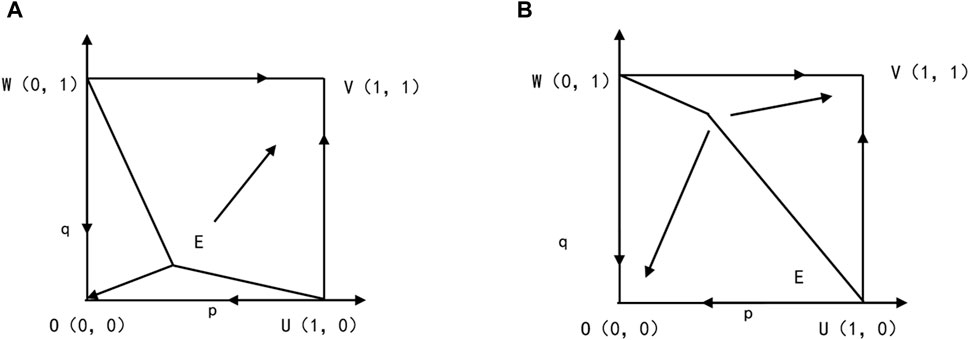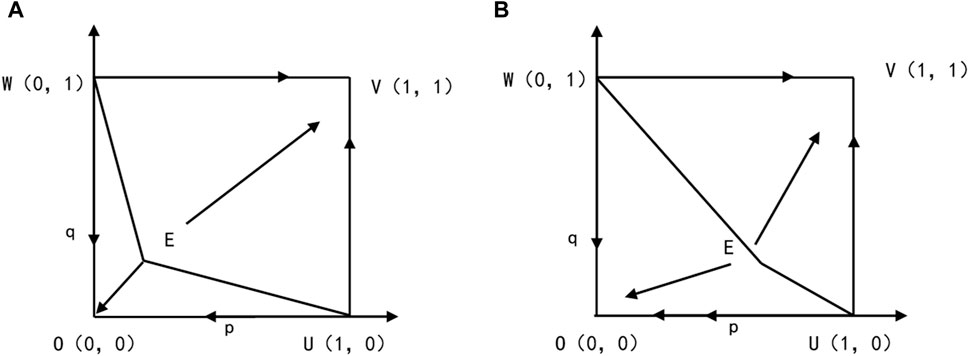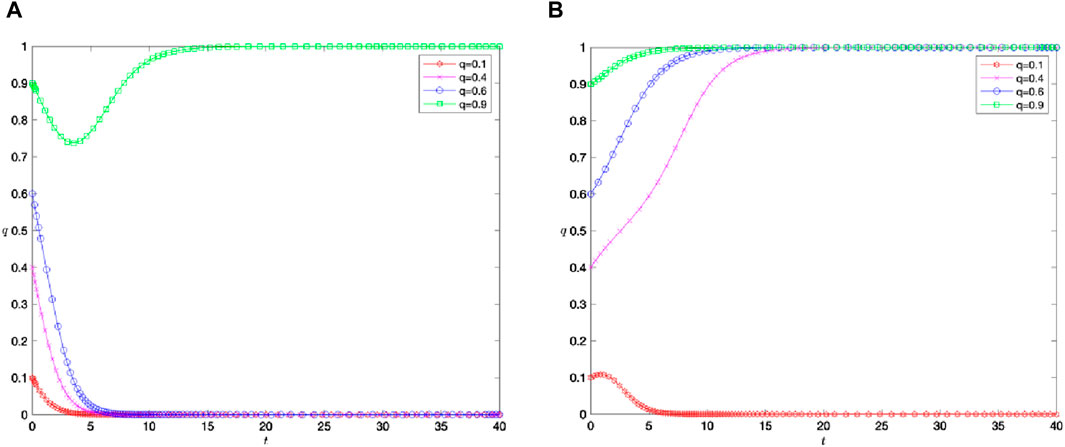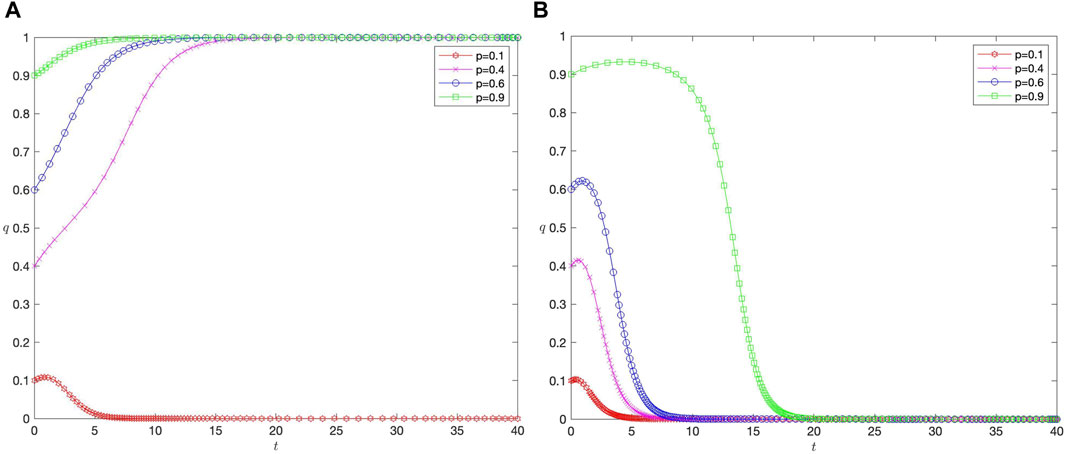
94% of researchers rate our articles as excellent or good
Learn more about the work of our research integrity team to safeguard the quality of each article we publish.
Find out more
ORIGINAL RESEARCH article
Front. Phys., 06 May 2024
Sec. Social Physics
Volume 12 - 2024 | https://doi.org/10.3389/fphy.2024.1364550
This article is part of the Research TopicReal-World Applications of Game Theory and OptimizationView all 17 articles
Organizational innovation performance is considered to be the key to maintaining competitiveness and achieving sustainable development in modern enterprises. Deviant innovation refers to that employees improve their working methods without the permission of the organization, break through the constraints of existing rules and achieve high performance. Additionally, Deviant innovation behavior can also stimulate the enthusiasm of other members of the organization. In order to study the evolutionary game rules of strategic interaction between enterprises and employees in the process of deviant innovation, this paper constructs a 2*2 asymmetric payoff matrix, and uses numerical simulation to show the influence of different values of decision parameters and changes of initial conditions on the evolutionary results. The research reveals that the interaction game between employees’ deviant innovation behavior and enterprise enhancement of organizational innovation performance is a complex and significant topic. It is found that when enterprises actively improve organizational innovation performance and employees implement deviant innovation behavior, both sides engage in positive game interactions, maximizing enterprise benefits. However, when enterprises passively enhance organizational innovation performance but employees engage in deviant innovation behavior, it may lead to conflicts between the two parties. The research findings provide relevant strategies for employees to correctly implement deviant innovation behavior and for enterprises to enhance organizational innovation performance.
In modern enterprises, organizational innovation performance is considered to be the key to maintaining competitiveness and achieving sustainable development. However, innovation is no longer solely the responsibility of senior management but increasingly relies on employees at all levels within the organization. Deviant innovation refers to that employees improve their working methods without the permission of the organization, break through the constraints of existing rules and aim to improve the interests of the organization [1]. We find that employees’ positive deviant innovation behavior can prompt enterprises to better integrate and utilize internal and external resources, promote the landing of innovation culture, and accelerate the promotion of innovation projects, thus enhancing the innovation competitiveness of the enterprise and further optimizing the innovation performance of the organization [2].
Organizational innovation performance, as a comprehensive reflection of various innovation achievements of the enterprise, is expressed as the overall role and impact results brought to the enterprise from the generation of innovative ideas and the adoption of innovative measures to apply them to the actual production and operation activities, which itself is a multi-level concept [3]; [4]. This study believes that employees’ deviant innovation behaviors can motivate other members of the organization, trigger chain reactions internally, and promote broader innovation, thus greatly contributing to the improvement of organizational innovation performance. When enterprises actively enhance organizational innovation performance and provide sufficient resources and support, while employees also engage in deviant innovation behavior, an ideal state is achieved. At this point, employees and enterprises jointly achieve optimal interaction effects, creating a win-win situation [5].
Evolutionary game theory is an interdisciplinary fusion theory that combines evolutionary biology and classical game theory [6]. It views individual strategies and behaviors as continually evolving through the transmission of genetic information and random mutations. In evolutionary game theory, individual behaviors are strategies, and the evolutionary process is a dynamic game process. Individuals adapt and adjust their strategies by considering the pros and cons of different strategies [7].
Currently, evolutionary game theory has become one of the primary mathematical tools for research in economics and finance [8]. In recent years, numerous scholars both domestically and internationally have conducted research in this field. Eid et al. [9] finds out the balanced distribution of post-disaster insurance plans purchased by households and sold by insurance companies and post-disaster relief implemented by government agencies. Feng and Hu [10] investigated the evolutionary game of financing empowerment mechanisms for the digital transformation of small and medium-sized enterprises, exploring the impacts of core enterprise support and government subsidies on the digital transformation financing of small and medium-sized enterprises.
In the practice of enterprises enhancing innovation performance and employees engaging in deviant innovative behavior, evolutionary game theory also provides a practical analytical framework. When employees are faced with different company innovation atmospheres and leadership decisions, their choices regarding deviant innovation exhibit characteristics of evolutionary game theory. Similarly, when enterprises decide on the level of investment in innovation, they consider various factors such as employee capabilities, operational objectives, and return on investment [11]. However, in situations of incomplete information, they often make decisions based on personal experience and habits, leading to interactive games between both parties. Therefore, to study the interaction between enterprises and employees, this paper constructs a dynamic game model composed of enterprises and employees.
Due to the short-sighted behavior under the condition of limited rationality, in the process of innovation, whether the enterprise actively improves the organizational innovation performance and the employee’s deviant innovation behavior is a dynamic process of continuous adjustment, similar to the characteristics in ecology. Enterprises, considering long-term benefits, may to some extent enhance organizational innovation performance [12]. However, their performance may be influenced by employees’ deviant innovation behavior, which can manifest in two ways: 1) positively enhancing organizational innovation performance (A1) with a probability of p; 2) negatively enhancing organizational innovation performance (A2) with a probability of 1-p.
Similarly, assuming that the employees will initially engage in deviant innovation behaviors, and during the process from initiating deviant innovation to executing it, they will continuously adjust their behavior patterns. Therefore, the employees will also have two choices: 1) to carry out the deviant innovation behavior (B1), with the probability of q; 2) not to carry out the deviant innovation behavior (B2), with the probability of 1-q, the payoff matrix for the two sides of the game as shown in Table 1.
The interpretation of the matrix is as follows: 1) When the company actively improves its organizational innovation performance and the employees conduct deviant innovation behaviors, the company’s profit is represented as
According to the Malthusian dynamic equation [13], which states that the growth rate of a strategy is equal to its relative fitness, specifically as long as the fitness of individuals adopting the strategy is higher than the average fitness of the group, the strategy will grow over time. Therefore, the dynamical equation for the strategic interaction between organizational innovation performance and employees’ deviant innovation over time is:
According to equation set (1), we can study the evolution of organizational innovation performance and employees’ strategic interaction behavior of deviant innovation. Let the Jacobian matrix of the system of equations (8.80) be J, then Eq. 2 can be derived.
Denoting the determinant of J as Det(J), and then we can discuss the stability of the system of Eq. 1.
Let
From Table 2, two of the five equilibrium points of the system are stable points, representing Evolutionarily Stable Strategies (ESS), corresponding to two game modes: 1) Mode (A1, B1) is that the employees engage in the deviant innovation behavior while the company positively enhances organizational innovation performance; 2) Mode (A2, B2) is that the employees do not engage in deviant innovation behavior while the enterprise passively enhances organizational innovation performance. Figure 1 illustrates the dynamic evolution process of organizational innovation performance and employees’ deviant innovation behavior.
In Figure 1, the discount connected by two imbalance points (0,1), (1,0) and saddle point E (
When the parameters related to deviant innovation behavior and organizational innovation performance change, the speed of convergence of the model is also affected.
(1) The effect on the rate of convergence of the firm’s benefit B from the employee’s deviant innovation behavior and the employee’s deviant innovation and hence performance pay C. At the saddle point,
(2) Similarly, the impact of the company’s inputs K to improve the organizational innovation performance and the benefits X derived by the employees on the rate of convergence is shown in Figure 2. Because X′(K) > 0, indicating that within the domain of definition, a monotonic function possesses an inverse function, hence K′(X) > 0. This can be interpreted as follows: in an environment where employees actively strive to enhance organizational innovation performance, greater benefits can be obtained through the implementation of deviant innovation behaviors, thus promoting the survival and development of the enterprise. Consequently, the firm tends to invest more in this regard. X does not directly influence the convergence speed but affects it through the parameter K. In an environment where organizational innovation enhancement is lacking, the impact of loss D on the convergence speed when employees persist in implementing deviant innovation is depicted in Figure 3.

Figure 2. Effect of variation of parameters B, K on convergence rate. (A) When B increases and K decreases. (B) When B decreases and K increases.

Figure 3. Effect of variation of parameters C, D on convergence rate. (A) When C increases and D decreases. (B) When C decreases and D increases.
Next, by means of numerical experiments, we analyze the effects on the evolutionary results of the changes in parameters such as the proportion of the initial population choosing a certain strategy, the inputs carried out by enterprises to positively enhance the innovative performance of the organization, the additional benefits gained by the enterprises and the employees from the innovative behaviors, and the losses suffered by the employees who transgressed the innovation as a result of the negative enhancement of innovative performance of the organization.
(1) First of all, in this issue, we focus on the impact of the initial population proportion to choose the relevant strategy on the evolutionary outcome. The results of the numerical experiments are illustrated in Figure 4 below, where p and q respectively denote the initial proportions of firms choosing to actively enhance organizational innovation performance and the proportions of employees practicing deviant innovation behaviors. The horizontal axis represents time, and the vertical axis represents the proportion of employees who perform deviant innovative behaviors. The values of the parameters are K = 1, B = 2, C = 0.5, D = 1.

Figure 4. Effect of changes in the proportion of the initial population choosing a particular strategy on evolutionary outcomes. (A) p = 0.2. (B) p = 0.8.
From the figure, it can be observed that the evolutionary paths of employees’ deviant innovations and firms’ organizational innovation behaviors depend largely on the choice of initial probabilities. The four different trajectories start from different initial probabilities and do not intersect or overlap before converging to the equilibrium state. In addition, the time required to converge to the equilibrium state varies in relation to the initial proportion of the population whose employees perform the deviant innovation behavior. The closer the initial proportion is to the equilibrium state, the faster the convergence. Comparing the two sub-figures in Figure 2: we can see that the evolutionary outcome of employee behavior and the time of convergence are not only affected by the initial proportion of employees who choose deviant innovative behavior, but also by the initial proportion of the corporate population that actively improves the innovative performance of the organization. The closer the initial proportion is to the ideal state, the greater the possibility that the evolution of employee behavior will reach the ideal state.
(2) In order to understand the impact of firms’ inputs to enhance organizational innovation performance on evolutionary outcomes, we conducted numerical experiments, the results of which are shown in Figure 5 below. In the figure, the horizontal axis represents time and the vertical axis represents the proportion of firms that are actively engaged in strategies to enhance organizational innovation performance. The proportion of employees choosing to perform deviant innovative behaviors is 0.8 (q = 0.8), and the other parameters are B = 2, C = 0.5, and D = 1.

Figure 5. Impact of changes in firms’ inputs to actively improve organizational innovation performance on evolutionary outcomes. (A) k = 1. (B) k = 2.
Comparing the results in Figures 5A, B, we can observe that as the firm’s investment in enhancing organizational innovation performance increases, the interaction behavior between the firm and its employees evolves to a completely different state, namely, mode (A2, B2). In this pattern, firms adopt negative strategies to enhance organizational innovation performance, while employees no longer perform deviant innovation behaviors, which is an undesirable locking state. However, ideally firms should actively enhance organizational innovation performance, so it is important to note that more investment is not always better, because it may fall into an undesirable locking state after exceeding a certain limit.
(3) Changes in firms’ earnings have a significant impact on the evolutionary outcomes, and the results of the numerical experiments are shown in Figure 6. In the figure, the horizontal axis represents time, and the vertical axis represents the proportion of firms choosing to actively improve organizational innovation performance. The proportion of employees choosing to transgress innovation is 0.8, and the other parameters are K = 1, C = 0.5, and D = 1. By comparing the results in Figures 6A, B, it can be observed that the benefits that firms gain from the deviant innovation behaviors of their employees have a significant impact on the evolution of the interactive behaviors between firms and their employees to the desired state. When the proportion of employees engaging in deviant innovation is higher, the firm’s gain increases accordingly, which motivates the firm to be more active in improving organizational innovation performance, thus creating a win-win situation.
(4) The loss of deviant innovation behaviors suffered by employees has an impact on the evolutionary outcome in the case of firms taking negative measures to enhance organizational innovation performance, and the results of the numerical experiment are shown in Figure 7 below. In the figure, the horizontal axis represents time and the vertical axis represents the proportion of employees who choose deviant innovative behavior. The proportion of firms choosing to positively enhance organizational innovation performance is 0.8, and the other parameters are K = 1, B = 2, and C = 0.5. By comparing the results in Figures 7A, B, it can be observed that when the loss suffered by employees due to deviant innovation behaviors increases, it is more likely that the interaction behaviors between the firms and the employees will evolve into the (A2, B2) pattern. This is because if an employee’s deviant innovative behavior may lead to an increase in the likelihood or degree of task conflict escalating into emotional conflict, then the psychological loss suffered by the employee will increase accordingly, which may lead the employee to choose a more conservative strategy, i.e., not to engage in deviant innovative behavior.
The game analysis of the interaction between employees’ deviant innovation and enterprises’ organizational innovation performance provides us with profound insights into the complex relationship between employees’ deviant innovation behaviors and enterprises’ organizational innovation performance. It is initially found that when the enterprise actively improves organizational innovation performance and the employees implement deviant innovation behaviors, both sides of the game are positive, which maximizes the interests of the enterprise; when the enterprise actively improves organizational innovation performance but the employees do not implement deviant innovation behaviors, the enterprise’s earnings are relatively reduced while the employee’s earnings are affected by the environment to a certain extent; when the enterprise negatively improves organizational innovation performance but the employees implement deviant innovation behaviors, it may lead to the escalation of task conflict and the increase in the number of employees. When the enterprise negatively improves the organizational innovation performance but the employees carry out the deviant innovation behavior, it may lead to the possibility or degree of task conflict escalation into emotional conflict increases, then the employees in the psychological loss will be increased accordingly, which may lead to the employees to choose a more conservative strategy, that is to say, the enterprise negatively improves the organizational innovation performance, the employees do not carry out the deviant innovation behavior of the undesirable locking state. In order to maximize the interests of both enterprises and employees, this paper proposes relevant measures based on the game results.
From the enterprise perspective, companies need to manage this interaction wisely, as this interactive game is one of the key factors for organizational success. Firstly, it is essential to define organizational performance goals, requiring thoughtful and effective strategic planning to ensure rational resource allocation [14]. If companies fail to provide sufficient resources for organizational innovation performance at the outset, employees may feel a lack of support, resulting in the failure of innovation activities. Secondly, fostering an open, inclusive, and innovative cultural atmosphere, establishing efficient innovation teams, and motivating employees’ deviant innovation behavior are crucial [15]. Thirdly, scientific management is required to facilitate positive interactions among employees. When employees actively engage in deviant innovation, companies can leverage their employees’ efforts to adjust their strategies to better respond to market demands. This includes enhancing products, services, or processes to meet evolving customer expectations [16]. Companies can thus adapt more rapidly to market dynamics, thereby enhancing organizational innovation performance.
From the employee perspective, proactive implementation of deviant innovation behavior by responsible employees is crucial [17]. Employees’ deviant innovation behavior can inspire other members within the organization, meaning that when one employee demonstrates courage and innovation capability, other members may be encouraged to actively participate in innovation activities. This internal motivation can significantly contribute to the improvement of organizational innovation performance, thereby enhancing internal cohesion within the company. However, deviant innovation should be controlled within a reasonable range, as only moderate deviant innovation is suitable for the long-term development of the enterprise.
To sum up, the interactive game between employees’ deviant innovation behavior and enterprises’ enhancement of organizational innovation performance is a complex and important theme. Employees’ positive deviant innovation behavior can stimulate the enthusiasm within the organization, and at the same time can help the enterprise to better cope with the market challenges. Organizations need to manage this interaction intelligently to ensure that resources are allocated appropriately to achieve optimal innovation performance. This interactive game is one of the key factors for organizational success and requires thoughtful and effective strategic planning. Only by running in the same direction, employees and organizations will work together to reach higher peaks of innovation.
The original contributions presented in the study are included in the article/supplementary material, further inquiries can be directed to the corresponding author.
HZ: Conceptualization, Methodology, Writing–original draft, Writing–review and editing. JL: Data curation, Software, Validation, Writing–original draft, Writing–review and editing. YC: Data curation, Software, Validation, Writing–review and editing. YG: Writing–review and editing. ZZ: Writing–review and editing.
The authors declare financial support was received for the research, authorship, and/or publication of this article. This research was funded by The National Natural Science Foundation of China, grant numbers 72072076 and 72372106, National Social Science Foundation of China, grant number 19BGL127.
The authors declare that the research was conducted in the absence of any commercial or financial relationships that could be construed as a potential conflict of interest.
The handling editor DH declared a shared affiliation with the authors HZ and YC at the time of review.
All claims expressed in this article are solely those of the authors and do not necessarily represent those of their affiliated organizations, or those of the publisher, the editors and the reviewers. Any product that may be evaluated in this article, or claim that may be made by its manufacturer, is not guaranteed or endorsed by the publisher.
1. Zhang LY, Wu MY, Li SY, Liu R, Zhu Y. Exploring the dynamics of role transition of employees in family businesses through the evolutionary game theory. Front Phys (2023) 11:1295646. doi:10.3389/fphy.2023.1295646
2. Zhang Q, Zhang HF. A study on the impact of employee's constructive deviant behavior on their innovation performance based on the perspective of manager's meaning construction. J Xidian Univ (2023) 33(04):30–46.
3. Jiang Y. A review of research on employee transgressive innovation behavior and its prospects. Sci Tech Management Res (2018) 38(10):131–9. doi:10.3969/j.issn.1000-7695.2018.10.018
4. Ye CJ, Liu AL. Leaders' bottom-line mindfulness and employees' transgressive innovation-a moderated mediation mode. Sci Tech Management Res (2023) 43(12):176–82. doi:10.3969/j.issn.1000-7695.2023.12.020
5. Li YZ. The impact of transformational leadership on employee innovation behavior. The role of psychological empowerment and emotional commitment. Res Management (2018) 39(07):123–30. doi:10.19571/j.cnki.1000-2995.2018.07.015
6. Kai-Ineman DANIEL, Tversky A. Prospect theory: an analysis of decision under risk. Econometrica (1979) 47(2):363–91. doi:10.2307/1914185
7. Smith JM. Evolution and the theory of games. In: Did Darwin get it right? Essays on games, sex and evolution. Boston, MA: Springer US (1982). p. 202–15.
8. Amir R, Evstigneev VI, Schenk-Hoppé KR. Asset market games of survival: a synthesis of evolutionary and dynamic games. Annals of Finance (2013) 9(2):121–144. doi:10.1007/s10436-012-0210-5
9. Eid MS, El-Adaway IH, Coatney KT, Evolutionary stable strategy for postdisaster insurance: game theory approach. J Management Eng (2015) 31(6):04015005. doi:10.1061/(asce)me.1943-5479.0000357
10. Feng M, Hu YF. A cross-level study of job stressors on employees' breakthrough and progressive creativity. J Management (2021) 18(07):1012–21. doi:10.3969/j.issn.1672-884x.2021.07.007
11. Welbourne TM, Johnson DE, Erez A. The role-based performance scale: validity analysis of a theory-based measure. Acad Manag J (1998) 41(5):540–55. doi:10.5465/256941
12. Wang L, Schuetz CG, Cai D. Choosing response strategies in social media crisis communication: an evolutionary game theory perspective. Inf Management (2021) 58(6):103371. doi:10.1016/j.im.2020.103371
14. Du PC, Fan MJ, Liu SY. The effect of job remodeling on employees' adaptive performance under the perspective of information processing theory. J Capital Univ Econ Business (2022) 24(02):101–12. doi:10.13504/j.cnki.issn1008-2700.2022.02.008
15. Roland Michel Déprez G, Battistelli A, Boudrias JS, Cangialosi N. Constructive deviance and proactive behaviors: two distinct approaches to change and innovation in the workplace. Le travail humain (2020) 83(3):235–67. doi:10.3917/th.833.0235
16. Wong SI, Kuvaas B. The empowerment expectation–perception gap: an examination of three alternative models. Hum Resource Management J (2018) 28(2):272–87. doi:10.1111/1748-8583.12177
Keywords: deviant innovation behavior, organizational innovation performance, evolutionary game, numerical experiment, undesirable locking state
Citation: Zheng H, Lu J, Chen Y, Gu Y and Zheng Z (2024) A game study on the impact of employees’ deviant innovation behaviors on firms’ organizational innovation performance. Front. Phys. 12:1364550. doi: 10.3389/fphy.2024.1364550
Received: 02 January 2024; Accepted: 09 April 2024;
Published: 06 May 2024.
Edited by:
Dun Han, Jiangsu University, ChinaReviewed by:
Jinlong Ma, Hebei University of Science and Technology, ChinaCopyright © 2024 Zheng, Lu, Chen, Gu and Zheng. This is an open-access article distributed under the terms of the Creative Commons Attribution License (CC BY). The use, distribution or reproduction in other forums is permitted, provided the original author(s) and the copyright owner(s) are credited and that the original publication in this journal is cited, in accordance with accepted academic practice. No use, distribution or reproduction is permitted which does not comply with these terms.
*Correspondence: Jie Lu, NjAzNTEzNTc1QHFxLmNvbQ==
Disclaimer: All claims expressed in this article are solely those of the authors and do not necessarily represent those of their affiliated organizations, or those of the publisher, the editors and the reviewers. Any product that may be evaluated in this article or claim that may be made by its manufacturer is not guaranteed or endorsed by the publisher.
Research integrity at Frontiers

Learn more about the work of our research integrity team to safeguard the quality of each article we publish.